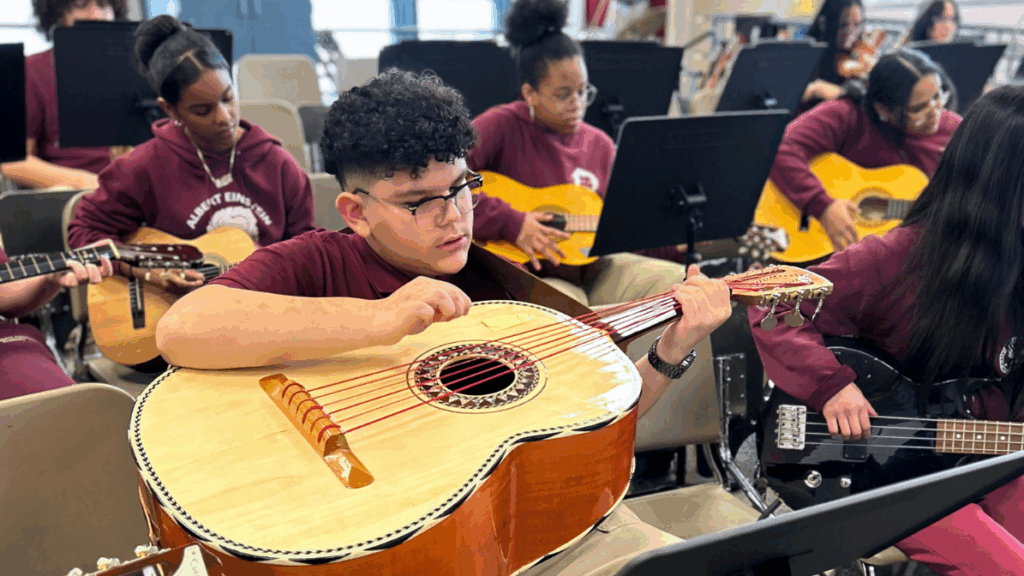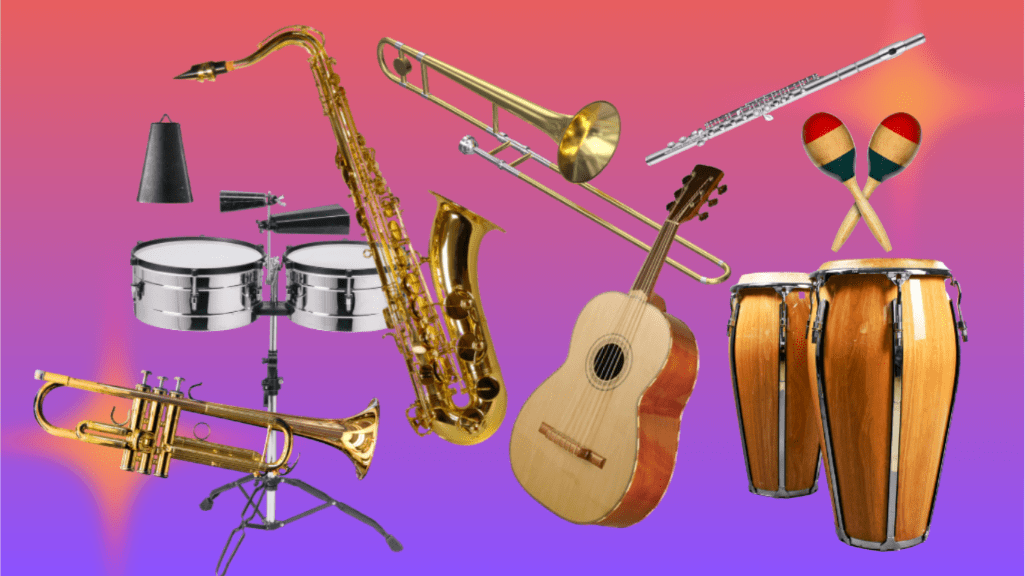In recent years, Latin music has grown from a niche category to a global soundtrack. As the fastest-growing streaming genre, topping charts and sweeping major awards, Latin music and its artists are having their rightful time in the spotlight—and school music programs have taken note.
At the same time, with Hispanic or Latino individuals now making up nearly 19% of the U.S. population, bringing Latin music into classrooms isn’t just timely—it makes music education more relevant, inclusive, and rewarding for every learner.
In this blog, we’ll explore how Latin music is shaping today’s schools: the growth of these programs, the benefits for students and communities, and the opportunities to expand access in public schools through organizations like Save The Music.
What Are Latin Music Genres?
Latin music is an umbrella term that covers a range of dynamic sounds, rooted in Latin America, the Caribbean, and Spain. While there’s some overlap in the music from these different regions, each still has distinct, unique elements that set it apart from the rest of the genre. Depending on the subgenre you’re listening to, you might hear influences that are European, Indigenous, African, or all of the above.
Latin music is so vibrant and diverse: you’re just as likely to hear it in a lively dance club as you are in a romantic restaurant. Many know it for its dance-friendly, high-energy rhythms, but Latin music can also be slow and soulful, or folky and festive. That musical richness has sparked several fusion genres from Latin music, including Latin Jazz and Reggaeton, a blend of Caribbean sounds with hip-hop and pop music.
Much of the genre’s varied sounds come from a handful of distinctive instruments. The guitarrón, for example, is often at the heart of mariachi music, while the conga keeps the energy going in Afro-Cuban tracks. In salsa, the clave creates its unique asymmetrical structure, whereas the dembow lends an unmistakable fast-paced rhythmic pattern in Reggaeton.
Popular Latin Music Styles in Education
Given its popularity, many Latin music categories have already made their way into the classroom at this point. Across the country, you might find any one of these genres highlighted in a music education course:
- Mariachi — Traditional Mexican music centered around trumpets, guitars, violins, and the guitarrón
- Salsa — An upbeat, dance-centric genre blending African and Cuban sounds
- Cumbia — Combining African, Indigenous, and Spanish elements, this Colombian style is usually easier for beginners to play
- Bachata — With roots in the Dominican Republic, this category of music focuses on cultural storytelling
- Merengue — Another style from the DR, this music is fast-paced and perfect for teaching coordination and timing
- Reggaetón — Classified as a pop genre by some, this lively genre originated in Puerto Rico and adds cultural relevance to the classroom
- Latin Jazz — Fusing jazz with Afro-Latin rhythms, Latin Jazz is perfect for advanced learners, looking to play outside the box
This diversity is exactly why Latin music genres have become such a valuable part of today’s classrooms.
Why Latin Music Matters in Education
When Latin music becomes part of the curriculum, students gain more than new songs. They build stronger skills, deeper cultural awareness, and lasting bonds with their peers and teachers. Below, we’ll dive into how making Latin music part of the curriculum strengthens the entire academic ecosystem.

Benefits for Students
Many public schools have long offered orchestra, choir, or band as core music programs. While these traditions provide meaningful opportunities for students, they don’t always reflect the diverse cultural backgrounds represented in today’s classrooms. By adding Latin music genres to the curriculum, schools can make their programs more inclusive and engaging for a wider range of students.
Latin music classes can help students bond with peers while deepening connections to their heritage, creating a greater sense of belonging.
But participating in music programs offers more than just cultural benefits. Research shows that students who play in a school music ensemble do better in math, science, and English. Involvement in a music program also bolsters a college resume, a perk that both students and parents can appreciate. Because Latin music attracts a wider range of students, it ensures that more young people gain the academic advantages that come with music education.
Benefits for School Communities
Making Latin music an integral part of the school music program doesn’t just benefit the students. Adding this program can also strengthen ties between students and teachers, parents and teachers, and schools and their communities.
When schools add Latin music to their music program, parents from Latin communities become more engaged in school events, attending music performances, conferences, open houses, and other school events.
Over time, the performances start attracting more of the Latin community at large, not just parents of students. From local residents to business owners, members of the Latin community attend the shows, building a bridge between the school and its neighbors. In a sense, the school becomes a hotspot for cultural connections. It’s this dynamic that aligns so well with Save The Music’s mission to restore and expand access to diverse music education, providing opportunities for every student to celebrate their culture through music.
These connections strengthen the role of schools as cultural hubs, with families and community members coming together to celebrate students’ achievements through music. They also give students meaningful opportunities to share their talents and deepen their pride in cultural expression.
Challenges and Opportunities
Schools throughout the country are finding ways to make Latin music a core part of their music programs. For example, both the Humble Independent School District in Texas and the Clark County School District in Nevada have added mariachi programs to multiple institutions. Likewise, Edison High School has added conjunto to its music offerings.
Thankfully, incorporating Latin music into the curriculum has been pretty seamless, with most schools integrating violins and trumpets from orchestras, bands, or other musical groups into Latin scores. In some cases, schools even find sheet music in community libraries to round out their offerings in the genre. Schools have also been able to create a more robust instructor roster by bringing in local professional musicians.
By partnering with cultural centers and music advocacy groups like Save The Music, schools gain access to resources and expertise that make Latin music programs even more viable and successful.
Resources for Educators Bringing Latin Music into the Classroom
Are you an educator or curriculum developer looking to add Latin music to your school? Below are helpful resources that can help you bring in different Latin music types—from mariachi to salsa to reggaetón—through donations, cultural mentorship, and ready-to-use lesson plans.
- Latin Percussion Stories: Rhythmology – provides a free collection of artist-instructed videos to hone your and your students’ percussion knowledge and technique
- The Latin GRAMMY Cultural Foundation – provides instrument donations, music education experiences, and grants for Latin music heritage research/preservation
- Volta Music Foundation — brings Latin music programs to schools in underserved communities, providing instruments and mentorship
- National Association of Latino Arts and Cultures — provides grants and leadership training for a range of Latino arts
- LessonPlanet — has a list of teacher-reviewed Latin American lesson plans and worksheets that instructors can easily integrate into their existing curriculum
- Save The Music’s Music Education Resources — our resources include music technology setup instructions, music theory lessons, and other digital tools to support your initiatives for adding Latin music to your program
These organizations and resources support diversity in school music programs, addressing issues like lack of instructor training and instruments as well as a shortage of ready-to-go lesson plans. Of course, you can always connect with Save The Music for additional support and inspiration.
Support the Growth of Latin Music in Schools with Save The Music
Latin music’s popularity and influence continue to grow, and bringing it into schools can spark student engagement, strengthen community connections, and create more inclusive classrooms. Every student deserves to see their culture and identity reflected in their music program—and Latin music is a powerful way to make that happen, ensuring public school music programs reflect the communities they serve.
At Save The Music, we believe all students should have access to diverse, high-quality music education. With your support, we can restore and expand these opportunities in classrooms nationwide. Join us by donating today, contacting us to learn how to bring music education to more schools, or exploring our Music Education Resources for tools to support your program.


